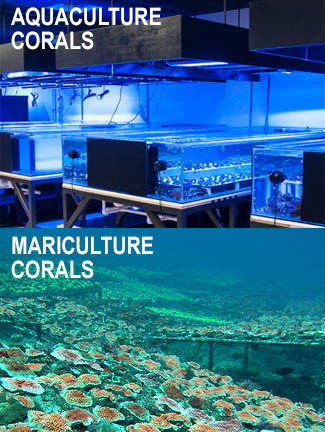 Should You Buy Captive Raised (Aquacultured) Corals, Coral Reef Corals or Maricultured Corals?
Should You Buy Captive Raised (Aquacultured) Corals, Coral Reef Corals or Maricultured Corals?
It has been a growing trend in the aquarium hobby to try to purchase only corals that are captive raised (also known as aquacultured corals). However there are also some disadvantages to purchasing only captive raised corals. We will review the advantages of captive raised corals as well as some of the limitations. Finally, we’ll discuss maricultured corals as an alternative to traditional aquacultured corals.
Note: Sorry, but we do not sell coral.
Why Buy Captive Raised Coral?
Captive Raised Corals Are Easier To Take Care Of
Because captive raised corals have spent there lives in aquariums, they are accustomed to aquarium lighting, water flow and water quality. Corals from the ocean are used to pristine reef conditions which are often far more stable than our home aquariums. Because of this discrepancy, many wild collected corals will struggle in adapting to aquarium conditions. If you are an experienced aquarist with a well maintained tank this may not be an issue, but for beginners, or those who simply want the highest chance of success, aquacultured corals are the best choice.
Captive Raised Corals Have Less Of An Impact On The EnvironmentAll reef keepers care about the coral reefs. By choosing to use only corals grown in aquariums you can eliminate the demand to take corals off the reef.
Captive Raised Corals Are More Attractive
Aquaculturing corals requires time, money and effort. Because of this people would be crazy to choose to grow out ugly corals. Generally, only the most attractive corals will be grown in captivity. If the coral farmer is going to go through the work, they want to make sure that it is worth it.
The limits Of Captive Raised Coral
Not All Corals Can Be Aquacultured
While there are more and more aquacultured corals available, many coral species will never be aquacultured. Many corals simply grow so slowly that it would not be economically viable to farm them for propagation. There are thousands of species of coral in the wild but only a few hundred being aquacultured. If you are looking for new unique coral colors you may only be able to find them in wild collected corals.
The common species can not be aquacultured include: Acanthaphylia (Meat Coral), Cynarina (Owl Eye Coral), Scolymia (Button Coral), Plergogyra (Bubble Coral), Cataphyllia (Elegance Coral), Trachyphillia (Open Brain Coral) and Fungia (Plate Coral). There are thousands of species of coral in the wild but only a few
hundred being aquacultured. You may find that the coral you are looking
for is simply not propagated yet. If you are looking for new unique
coral colors you may only be able to find them in wild collected corals.
Aquacultured Corals Are More Expensive
Even though collecting corals from the wild is difficult, it is still much more affordable than growing corals in captivity. Often aquacultured corals are as much as 3-4 times the price of a comparable wild coral.
Aquacultured Corals Are Generally Smaller
If you want larger corals, you may have to purchase ocean grown corals. Coral growers are generally able to get more money from a bunch of small frags rather than a few small colonies. If you are patient, these frags will turn into colonies, but if you want a full reef fast you may be out of luck.
Maricultured Corals
Maricultured corals represent an excellent alternative to aquacultured corals. These corals are sustainably farmed in the ocean. The closest analogy to the difference between aquacultured corals and maricultured corals is that of a greenhouse vs. an outdoor field. Just as a farmer uses the natural sunlight and soil to grow vegetables in his filed, mariculture coral farmers use the sun and natural seawater to grow corals.
The farmers place grates in the ocean and then attach coral fragments to these grates. They wait months to years before returning to harvest the corals that have grown on the grates. The advantage of this is that it uses no electricity and very little labor to grow the coral.
Because farmers only want to grow the most attractive corals they can find, maricultured corals are often very beautiful. They come in medium to large sizes since the cost to produce large corals is quite low.
Maricultured corals are also significantly more affordable than aquacultured corals since they are less resource intensive to grow. However, they have still been grown in the ocean so they do not adapt to aquarium conditions as easily as aquacultured corals.




























 Should You Buy Captive Raised (Aquacultured) Corals, Coral Reef Corals or Maricultured Corals?
Should You Buy Captive Raised (Aquacultured) Corals, Coral Reef Corals or Maricultured Corals?